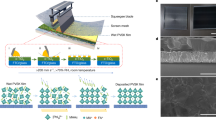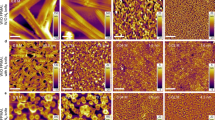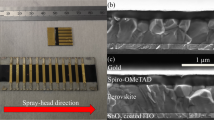Abstract
Perovskite solar cells have made tremendous progress using laboratory-scale spin-coating methods in the past few years owing to advances in controls of perovskite film deposition. However, devices made via scalable methods are still lagging behind state-of-the-art spin-coated devices because of the complicated nature of perovskite crystallization from a precursor state. Here we demonstrate a chlorine-containing methylammonium lead iodide precursor formulation along with solvent tuning to enable a wide precursor-processing window (up to ∼8 min) and a rapid grain growth rate (as short as ∼1 min). Coupled with antisolvent extraction, this precursor ink delivers high-quality perovskite films with large-scale uniformity. The ink can be used by both spin-coating and blade-coating methods with indistinguishable film morphology and device performance. Using a blade-coated absorber, devices with 0.12-cm2 and 1.2-cm2 areas yield average efficiencies of 18.55% and 17.33%, respectively. We further demonstrate a 12.6-cm2 four-cell module (88% geometric fill factor) with 13.3% stabilized active-area efficiency output.
This is a preview of subscription content, access via your institution
Access options
Access Nature and 54 other Nature Portfolio journals
Get Nature+, our best-value online-access subscription
$29.99 / 30 days
cancel any time
Subscribe to this journal
Receive 12 digital issues and online access to articles
$119.00 per year
only $9.92 per issue
Buy this article
- Purchase on Springer Link
- Instant access to full article PDF
Prices may be subject to local taxes which are calculated during checkout






Similar content being viewed by others
References
Kojima, A., Teshima, K., Shirai, Y. & Miyasaka, T. Organometal halide perovskites as visible-light sensitizers for photovoltaic cells. J. Am. Chem. Soc. 131, 6050–6051 (2009).
Kim, H.-S. et al. Lead iodide perovskite sensitized all-solid-state submicron thin film mesoscopic solar cell with efficiency exceeding 9%. Sci. Rep. 2, 591 (2012).
Lee, M. M., Teuscher, J., Miyasaka, T., Murakami, T. N. & Snaith, H. J. Efficient hybrid solar cells based on meso-superstructured organometal halide perovskites. Science 338, 643–647 (2012).
Burschka, J. et al. Sequential deposition as a route to high-performance perovskite-sensitized solar cells. Nature 499, 316–319 (2013).
Jeon, N. J. et al. Solvent engineering for high-performance inorganic–organic hybrid perovskite solar cells. Nat. Mater. 13, 897–903 (2014).
Jeon, N. J. et al. Compositional engineering of perovskite materials for high-performance solar cells. Nature 517, 476–480 (2015).
Yang, W. S. et al. High-performance photovoltaic perovskite layers fabricated through intramolecular exchange. Science 348, 1234–1237 (2015).
Best Research-Cell Efficiencies (NREL, 2016); http://www.nrel.gov/ncpv/images/efficiency_chart.jpg
Zhou, Y., Game, O. S., Pang, S. & Padture, N. P. Microstructures of organometal trihalide perovskites for solar cells: their evolution from solutions and characterization. J. Phys. Chem. Lett. 6, 4827–4839 (2015).
Aguiar, J. A. et al. In situ investigation of the formation and metastability of formamidinium lead tri-iodide perovskite solar cells. Energy Environ. Sci. 9, 2372–2382 (2016).
Williams, S. T., Rajagopal, A., Chueh, C.-C. & Jen, A. K. Y. Current challenges and prospective research for upscaling hybrid perovskite photovoltaics. J. Phys. Chem. Lett. 7, 811–819 (2016).
Razza, S., Castro-Hermosa, S., Di Carlo, A. & Brown, T. M. Research update: large-area deposition, coating, printing, and processing techniques for the upscaling of perovskite solar cell technology. APL Mater. 4, 091508 (2016).
Razza, S. et al. Perovskite solar cells and large area modules (100 cm2) based on an air flow-assisted PbI2 blade coating deposition process. J. Power Sources 277, 286–291 (2015).
Yang, Z. et al. High-performance fully printable perovskite solar cells via blade-coating technique under the ambient condition. Adv. Energy Mater. 5, 1500328 (2015).
Deng, Y. et al. Scalable fabrication of efficient organolead trihalide perovskite solar cells with doctor-bladed active layers. Energy Environ. Sci. 8, 1544–1550 (2015).
Hwang, K. et al. Toward large scale roll-to-roll production of fully printed perovskite solar cells. Adv. Mater. 27, 1241–1247 (2015).
Barrows, A. T. et al. Efficient planar heterojunction mixed-halide perovskite solar cells deposited via spray-deposition. Energy Environ. Sci. 7, 2944–2950 (2014).
Wei, Z., Chen, H., Yan, K. & Yang, S. Inkjet printing and instant chemical transformation of a CH3NH3PbI3/nanocarbon electrode and interface for planar perovskite solar cells. Angew. Chem. Int. Ed. 53, 13239–13243 (2014).
Li, S.-G. et al. Inkjet printing of CH3NH3PbI3 on a mesoscopic TiO2 film for highly efficient perovskite solar cells. J. Mater. Chem. A 3, 9092–9097 (2015).
Chen, H., Wei, Z., Zheng, X. & Yang, S. A scalable electrodeposition route to the low-cost, versatile and controllable fabrication of perovskite solar cells. Nano Energy 15, 216–226 (2015).
Huang, J.-H. et al. Direct conversion of CH3NH3PbI3 from electrodeposited PbO for highly efficient planar perovskite solar cells. Sci. Rep. 5, 15889 (2015).
Back, H. et al. Interfacial modification of hole transport layers for efficient large-area perovskite solar cells achieved via blade-coating. Sol. Energy Mater. Sol. Cells 144, 309–315 (2016).
Mallajosyula, A. T. et al. Large-area hysteresis-free perovskite solar cells via temperature controlled doctor blading under ambient environment. Appl. Mater. Today 3, 96–102 (2016).
Ro, H. W. et al. Morphology changes upon scaling a high-efficiency, solution-processed solar cell. Energy Environ. Sci. 9, 2835–2846 (2016).
Matteocci, F. et al. Solid-state solar modules based on mesoscopic organometal halide perovskite: a route towards the up-scaling process. Phys. Chem. Chem. Phys. 16, 3918–3923 (2014).
Priyadarshi, A. et al. A large area (70 cm2) monolithic perovskite solar module with a high efficiency and stability. Energy Environ. Sci. 9, 3687–3692 (2016).
Seo, J. et al. Benefits of very thin PCBM and LiF layers for solution-processed p-i-n perovskite solar cells. Energy Environ. Sci. 7, 2642–2646 (2014).
Qiu, W. et al. Pinhole-free perovskite films for efficient solar modules. Energy Environ. Sci. 9, 484–489 (2016).
Mei, A. et al. A hole-conductor-free, fully printable mesoscopic perovskite solar cell with high stability. Science 345, 295–298 (2014).
Salim, T. et al. Perovskite-based solar cells: impact of morphology and device architecture on device performance. J. Mater. Chem. A 3, 8943–8969 (2015).
Xiao, M. et al. A fast deposition-crystallization procedure for highly efficient lead iodide perovskite thin-film solar cells. Angew. Chem. Int. Ed. 53, 9898–9903 (2014).
Ahn, N. et al. Highly reproducible perovskite solar cells with average efficiency of 18.3% and best efficiency of 19.7% fabricated via Lewis base adduct of lead(II) iodide. J. Am. Chem. Soc. 137, 8696–8699 (2015).
Zhao, Y. X. & Zhu, K. CH3NH3Cl-assisted one-step solution growth of CH3NH3PbI3: structure, charge-carrier dynamics, and photovoltaic properties of perovskite solar cells. J. Phys. Chem. C 118, 9412–9418 (2014).
Yan, K. et al. Hybrid halide perovskite solar cell precursors: colloidal chemistry and coordination engineering behind device processing for high efficiency. J. Am. Chem. Soc. 137, 4460–4468 (2015).
Zhou, Y. et al. Room-temperature crystallization of hybrid-perovskite thin films via solvent-solvent extraction for high-performance solar cells. J. Mater. Chem. A 3, 8178–8184 (2015).
Jo, Y. et al. High performance of planar perovskite solar cells produced from PbI2(DMSO) and PbI2(NMP) complexes by intramolecular exchange. Adv. Mater. Interfaces 3, 1500768 (2016).
Zhou, H. et al. Interface engineering of highly efficient perovskite solar cells. Science 345, 542–546 (2014).
Yang, M. et al. Square-centimeter solution-processed planar CH3NH3PbI3 perovskite solar cells with efficiency exceeding 15%. Adv. Mater. 27, 6363–6370 (2015).
Xiao, Z. et al. Solvent annealing of perovskite-induced crystal growth for photovoltaic-device efficiency enhancement. Adv. Mater. 26, 6503–6509 (2014).
Kim, H. D., Ohkita, H., Benten, H. & Ito, S. Photovoltaic performance of perovskite solar cells with different grain sizes. Adv. Mater. 28, 917–922 (2016).
Della Gaspera, E. et al. Ultra-thin high efficiency semitransparent perovskite solar cells. Nano Energy 13, 249–257 (2015).
Ramirez Quiroz, C. O. et al. Pushing efficiency limits for semitransparent perovskite solar cells. J. Mater. Chem. A 3, 24071–24081 (2015).
Chen, B. et al. Efficient semitransparent perovskite solar cells for 23.0%-efficiency perovskite/silicon four-terminal tandem cells. Adv. Energy Mater. 6, 1601128 (2016).
Ihly, R. et al. Efficient charge extraction and slow recombination in organic-inorganic perovskites capped with semiconducting single-walled carbon nanotubes. Energy Environ. Sci. 9, 1439–1449 (2016).
Wojciechowski, K. et al. Heterojunction modification for highly efficient organic-inorganic perovskite solar cells. Acs Nano 8, 12701–12709 (2014).
Ip, A. H. et al. A two-step route to planar perovskite cells exhibiting reduced hysteresis. Appl. Phys. Lett. 106, 143902 (2015).
Ke, W. et al. Cooperative tin oxide fullerene electron selective layers for high-performance planar perovskite solar cells. J. Mater. Chem. A 4, 14276–14283 (2016).
Li, X. et al. A vacuum flash-assisted solution process for high-efficiency large-area perovskite solar cells. Science 353, 58–62 (2016).
Huang, F. et al. Gas-assisted preparation of lead iodide perovskite films consisting of a monolayer of single crystalline grains for high efficiency planar solar cells. Nano Energy 10, 10–18 (2014).
Acknowledgements
The work at the National Renewable Energy Laboratory is supported by the US Department of Energy under Contract No. DE-AC36-08GO28308. We acknowledge the support by the hybrid perovskite solar cell program of the National Center for Photovoltaics funded by the US Department of Energy, Office of Energy Efficiency and Renewable Energy, Solar Energy Technologies Office. We thank S. Mauger for help with XRF and viscosity measurement.
Author information
Authors and Affiliations
Contributions
K.Z. and M.Y. conceived the idea and designed the experiment. M.Y., Z.L., and D.H.K. fabricated and characterized perovskite thin film and devices. M.Y. and M.O.R. optimized large-area devices. M.Y., T.R.K., K.Z., and M.F.A.M.v.H. fabricated and characterized mini-module. M.Y. and S.S. measured XRF. K.Z., J.J.B., and M.F.A.M.v.H. supervised this project. K.Z. and M.Y. wrote the manuscript with inputs and discussion from all authors.
Corresponding authors
Ethics declarations
Competing interests
The authors declare no competing financial interests.
Supplementary information
Supplementary Information
Supplementary Figures 1–13 and Supplementary Tables 1–3 (PDF 1177 kb)
Rights and permissions
About this article
Cite this article
Yang, M., Li, Z., Reese, M. et al. Perovskite ink with wide processing window for scalable high-efficiency solar cells. Nat Energy 2, 17038 (2017). https://doi.org/10.1038/nenergy.2017.38
Received:
Accepted:
Published:
DOI: https://doi.org/10.1038/nenergy.2017.38
This article is cited by
-
A thermotropic liquid crystal enables efficient and stable perovskite solar modules
Nature Energy (2024)
-
Strain regulates the photovoltaic performance of thick-film perovskites
Nature Communications (2024)
-
Controlled growth of perovskite layers with volatile alkylammonium chlorides
Nature (2023)
-
Green solvent enabled scalable processing of perovskite solar cells with high efficiency
Nature Sustainability (2023)
-
A green solvent increases the stability of a perovskite ink for scalable processing
Nature Sustainability (2023)



